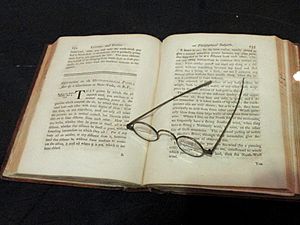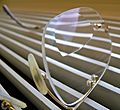Bifocals facts for kids

Bifocals are special eyeglasses that help people see clearly at different distances without needing to switch glasses. They have lenses split into two parts. The top part helps you see things far away, like a blackboard in a classroom or a street sign. The bottom part helps you see things up close, like reading a book or looking at your phone. This clever design means one pair of glasses can do the job of two!
Contents
Why Do People Need Bifocals?
As people get older, usually around their 40s, their eyes can start to have trouble focusing on objects both far away and up close. This common eye condition is called presbyopia. It happens because the natural lens inside the eye becomes less flexible, making it harder to change focus. Before bifocals, people with presbyopia had to carry two pairs of glasses: one for reading and one for seeing far away. Imagine how annoying that would be! Bifocals solved this problem by combining both types of lenses into one.
Who Invented Bifocals?
The idea for bifocals is often credited to the famous American inventor and statesman Benjamin Franklin. In the late 1700s, Franklin was living in France and found it inconvenient to switch between his reading glasses and his distance glasses. He wrote a letter in 1784 describing how he cut his two pairs of lenses in half and put them together in one frame. The top half was for looking at distant objects, and the bottom half was for reading. This simple yet brilliant solution made life much easier for many people.
How Do Bifocals Work?
Bifocal lenses work by having two different strengths, or "powers," in one lens.
The Top Part
The upper section of a bifocal lens is designed for distance vision. This part helps light from far-away objects focus correctly on the retina at the back of your eye. It's like having a regular pair of glasses for seeing things far away.
The Bottom Part
The lower section is for near vision, like reading or doing close-up work. This part has a stronger magnifying power. When you look down to read, your eyes naturally shift to use this lower part of the lens, which helps the words on a page appear clear and in focus.
Different Kinds of Bifocals
While Benjamin Franklin's original design had a clear line separating the two parts of the lens, modern bifocals come in different styles:
- Lined Bifocals: These are the traditional type, with a visible line separating the distance and near vision sections. The reading segment can be shaped like a half-moon, a round segment, or a narrow rectangle.
- No-Line Bifocals (Progressive Lenses): These are also known as progressive lenses or varifocals. They don't have a visible line. Instead, the lens gradually changes power from distance vision at the top to near vision at the bottom. This provides a smooth transition for vision at all distances in between, but they can take a little getting used to.
The Impact of Bifocals
Bifocals were a huge step forward in eye care. They made it much more convenient for people with presbyopia to go about their daily lives without constantly switching glasses. This invention improved the quality of life for millions and paved the way for even more advanced lens technologies, like progressive lenses, that we use today. It's a great example of how a simple idea can solve a big problem and make a lasting difference.
Images for kids
See also
 In Spanish: Lente bifocal para niños
In Spanish: Lente bifocal para niños



